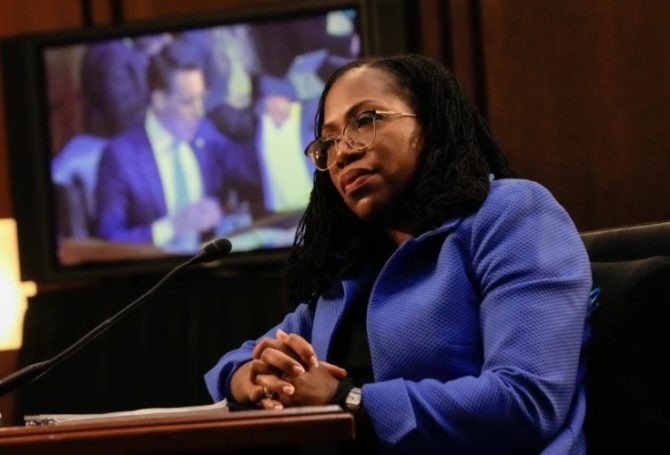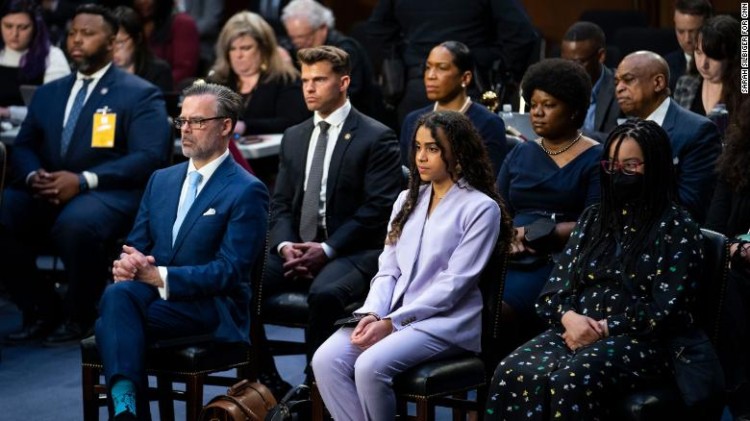
In media interviews, what you don’t say is just as important as what you do say. The Senate Judiciary hearing this week on the confirmation of Ketanji Brown Jackson as a justice to the US Supreme Court is an excellent example.
The four-day ordeal of confirmation hearings includes two long days of questions and responses sandwiched between opening statements and public testimony. Supreme Court nominees face a mix of praise wrapped around softball questions and treacherous questions intended to trip up the nominee and score political points. Political roles reverse depending on which party’s President nominated the judicial candidate.
Jackson has shown herself adept at both answering some questions and avoiding others. She has followed what has become the tradition of Supreme Court nominees of all ideological stripes to refuse to answer questions about matters that could come before the high court. Jackson even declined to share her political opinions, which she admits having, noting the job of a judge is to approach cases impartially, or as she put it, “to apply law to the facts without fear or favor”.
If you were to give Jackson a grade for her mastery of media training, it would be an A. Her performance is worth examining for its excellent technique.
Have a Message and Stick With It
In preparation for a Supreme Court confirmation hearing, hundreds of people pore over the backgrounds, cases and personal life of nominees. All that research converts into a wide range of questions, some asked to provoke gotcha’ responses. It’s imperative, as a result, for candidates to have what amounts to a brand message that sums up who they are and how they would perform as a Supreme Court justice.
She also flashed a winning smile, and at moving moments during the hearings she responded with natural emotion. Jackson left an impression as a genuine person. That’s something media training cannot teach.
Jackson’s core message at the hearings is that she has a methodology for considering cases that includes understanding the arguments of both sides, closely reading the relevant statutes and court precedents and rendering a ruling with a thorough and transparent explanation of her reasoning. In answering friendly and unfriendly questions over two grueling days, Jackson repeated her core message multiple times – exactly what you are taught in stress-test media training sessions.
Her senatorial interrogators tried all kinds of tricks to get her off track. They mostly failed as she stuck with her core message. Only occasionally did she enhance her core message, and that was on purpose, too. She referred to studying the text of the US Constitution with an eye toward understanding the meaning of the words in the minds of the constitutional framers – a bone to those who subscribe to the judicial concept of originalism.
Even that slight diversion by Jackson was disarming. She described how the Supreme Court dealt with the question of unreasonable search and seizure involving cell phones and computers, which didn’t exist in colonial days. As if telling a story, Jackson said justices looked to what the authors of the Fourth Amendment would have considered “unreasonable” in their day and applied it to the role of technology in modern life.
Just Answer the Question
Knowledgeable people smother an answer to a question in a mound of unnecessary detail. Jackson demonstrated discipline to keep her answers mostly on track during 23 hours of grilling. When she could, Jackson gave short answers. For questions requiring a more substantive response, she stuck close to the topic – and her core message.
An important element of media training is developing the skill – and discipline – to respond to questions directly, even if the response is you don’t have the answer. Direct responses tend to establish trust with the interviewer and the ultimate audience.
While there are moments they demand some level of emotional response, most interview questions should be addressed calmly and dispassionately. Jackson exhibited those traits in the face of adversarial questioning, especially in answer to a hostile question asking whether she regrets a particular sentence she handed down. Her response was to express regret that a hearing for a Supreme Court Justice nominee focused on a small subset of her entire 10-year work as a federal judge. It was a tough response wrapped in cool.
Understand and Prepare for Lines of Attack
Republican senators intensely questioned Jackson about her role as a federal public defender representing clients incarcerated at Guantanamo and her rulings on cases involving child pornography. Jackson had clearly anticipated and prepared to answer both.
Jackson made a constitutional case for public defenders. She said the US criminal system uniquely relies on a presumption of innocence as well as competent prosecutors and defense counsel to ensure fair trials and prevent government overreach. Public defenders represent indigent people who cannot afford to retain an attorney. In the case of Guantanamo detainees, public defenders represent people captured and imprisoned, often without being publicly charged.
In response to hostile questioning about her lenient sentencing of persons convicted of possessing child pornography, Jackson said she deplores the crime, but used the flexibility permitted by a Supreme Court ruling to mete out sentences appropriate to individual people. GOP Senators Ted Cruz and Josh Hawley pushed hard on this line of inquiry, but Jackson stood her ground without lashing out or losing her cool.
She did what media trainers advise in response to ambush questions – stay focused and on message.
Be Mindful of Body Language
Most interviews last less than 30 minutes. Jackson’s senatorial interrogation wore on for two full days. Regardless of how long the questioning continues, effective speakers must look composed and in control, which requires practice and concentration. Jackson exhibited both characteristics.
Sitting at a table with a single microphone, Jackson maintained eye contact with the senator she was addressing, a calm demeanor and a steady presence. She briefly showed emotion in describing her feelings as a mother about the crime of child pornography and the after-effects of victimized children. She avoided excessive hand gestures and didn’t squirm in her seat. She spoke without “umms” or slang.
These are traits of trial judges, but also the desired result of media training that helps speakers identify and overcome distracting vocal tics and gestures that can undermine what a person says.
Don’t Forget Stagecraft
Media trainers tell speakers they can decide where they speak or at least create the setting framing where they speak. The stagecraft for Jackson was her husband, two daughters, parents and brother sitting behind her at the hearing, sending a clear message about the importance of family. A key part of that message was the historic significance of Jackson’s nomination as the first Black woman to the Supreme Court.

“When I was born here in Washington, my parents were public school teachers, and to express both pride in their heritage and hope for the future, they gave me an African name; ‘Ketanji Onyika,’ which they were told means ‘lovely one,'” Jackson recalled in her opening statement. “My parents taught me that, unlike the many barriers that they had had to face growing up, my path was clearer, such that if I worked hard and believed in myself, in America I could do anything or be anything I wanted to be.”
During the second day of questioning, Jackson made the point about the progress of civil rights in America even clearer. She noted her parents grew up in Florida and attended segregated schools. By the time she was born in 1970 and went to school in Florida, schools were integrated. It was a deft way of expressing pride in America through a verbal family portrait.
Talk Like Speaking to a Jury
Lawyers talking to other lawyers can produce a jumble of words and references that the average person wouldn’t understand or bother to listen to for very long. A nominee for the Supreme Court must unavoidably talk about legal issues. Jackson, despite being an appellate judge, managed to minimize her legalese and talked most of the time as if speaking to a jury.
Talking to a jury is a good metaphor for how someone should make points and answer questions convincingly. Juries are a mix of people with different backgrounds and educational levels, but who collectively know little about the subject matter of a case at trial. The secret is to speak to the entire jury with clear expression, active language and commonly understood words. Get to the point and avoid tangents. Make your words count.
Stay True to Your Persona
Jackson is a Harvard graduate, so it would seem strange and contrived if she didn’t speak like a Harvard graduate. But sounding like a Harvard graduate doesn’t mean speaking pretentiously or condescendingly, which can put off audiences of almost any kind.
Media training encourages spokespersons to view their job like an actor performs a role. You must understand the character you play, know your lines and follow the script. Interviews are not improv theater. Spokesperson/actors should strive to be believable in the court of public opinion through their demeanor, clarity and composure.
At her hearing, Jackson spoke comfortably like a lawyer and judge who has dealt with people of all stations in life. Without overdoing it, Jackson referred to herself as a mom. She also flashed a winning smile, and at moving moments during the hearings she responded with natural emotion. Jackson left an impression as a genuine person. That’s something media training cannot teach.




